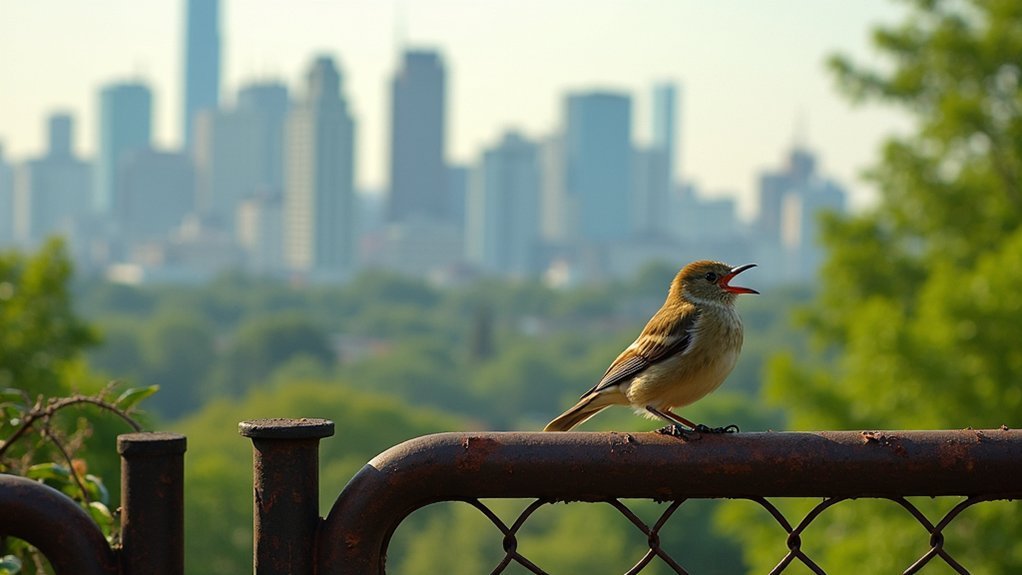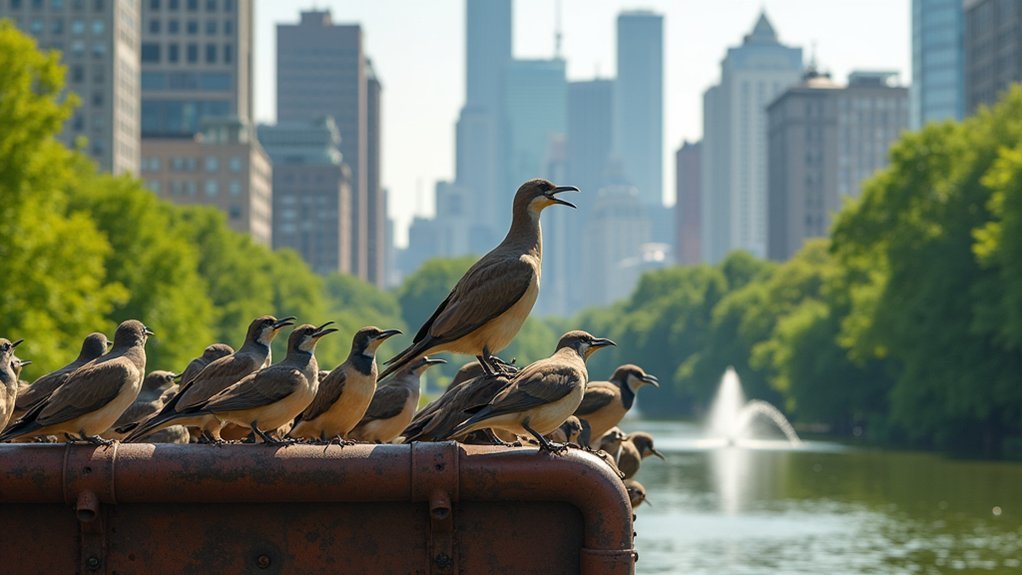Industrial noise pollution masks wildlife’s natural communication signals, forcing them to sing louder and at higher frequencies to be heard. Birds like sparrows and great tits must compete with traffic, machinery, and building-reflected sounds in urban areas. This “acoustic adaptation” causes physiological stress, disrupts mating calls, and threatens reproductive success. Sound-absorbing architecture and urban planning can help mitigate these effects, but the sonic battlefield continues to reshape how animals interact in our modern, noisy world.
The Acoustic Battlefield: How Urban Noise Reshapes Bird Communication

While we often admire birds for their melodious songs, the urban soundscape has forced many species to dramatically alter their vocal performances.
You’ll notice great tits and sparrows now sing louder and at higher frequencies to cut through the persistent din of traffic and human activity.
This isn’t just about volume—it’s a complete communication overhaul. Urban birds must navigate complex acoustic challenges created by buildings that reflect and distort sound waves. Their rural counterparts, free from such noise pollution, maintain their natural song patterns.
Ironically, though urban birds sing with greater power and higher pitch to compete with city noise, you might find their songs harder to hear.
These adaptations reshape not only their vocalizations but also their social dynamics as they battle in this acoustic warfare zone.
Higher Pitches and Louder Calls: Adaptations to Industrial Cacophony
As industrial machinery drowns out nature’s chorus, wildlife species have developed remarkable vocal adaptations to survive in our mechanized world.
You’ll notice songbirds like the great tit shifting to higher frequencies when competing with the rumble of traffic and drilling operations. This isn’t merely coincidental—it’s a strategic response to noise pollution.
When you visit urban environments, listen carefully to the sparrows. They’re singing louder and at higher pitches than their country cousins, effectively piercing through the industrial cacophony.
This adaptation comes at a cost, though. These birds experience increased stress levels as they strain to be heard above the mechanical din.
These vocal modifications represent wildlife’s resilience, but they also signal the profound ecological impact of our industrial soundscape on animal communication systems.
Architecture’s Role in Shaping Urban Bird Songs

You’ll notice that modern sound-absorbing building materials can considerably reduce the acoustic challenges faced by urban birds, allowing their songs to travel with less distortion.
Vertical gardens on building facades serve as natural buffers against industrial noise, creating acoustic oases where birds don’t need to modify their vocalizations as dramatically.
These architectural innovations represent a promising approach to mitigating the impact of urban soundscapes on avian communication.
Sound-Absorbing Building Materials
Urban architecture creates complex acoustic challenges for birds, forcing them to adapt their communication strategies in surprising ways.
When you examine modern cityscapes, you’ll notice how buildings reflect and distort bird songs, creating echoes that interfere with avian communication. As architects incorporate more sound-absorbing materials into urban buildings, this could directly affect how birds navigate these acoustic landscapes.
- Sound-absorbing facades can reduce echoes in narrow streets, potentially allowing birds to return to lower frequencies.
- Acoustic panels that minimize urban noise may decrease birds’ need to sing at higher frequencies.
- Green walls and vegetation buffers naturally absorb sound waves that would otherwise affect bird communication.
- Strategic building design can create acoustic corridors that preserve natural soundscapes despite surrounding development.
Vertical Gardens Buffer Noise
Three innovative approaches to vertical gardens are transforming urban acoustics for bird populations.
These living walls create sound-dampening effects that help shield songbirds from the relentless industrial noise that forces them to adapt their vocalizations to higher frequency ranges.
You’ll find that strategic placement of vertical gardens between buildings creates acoustic corridors where birds can communicate without competing with traffic sounds.
Additionally, multi-layered vegetation systems absorb different sound frequencies, creating pockets of relative quiet where birds don’t need to modify their natural songs as drastically.
Finally, seasonal rotation of plant species in vertical installations provides year-round acoustic benefits, as different foliage densities address varying sound challenges.
These green installations offer promising microhabitats where urban birds can maintain clearer communication patterns without straining to overcome the city’s acoustic obstacles.
Stress Responses and Hormonal Changes in Noise-Exposed Birds
When industrial noise pervades natural habitats, birds experience significant physiological stress responses, most importantly through elevated corticosterone levels.
You’ll notice these hormonal changes directly impact their survival mechanisms, forcing birds to adapt in harmful ways. They’ll sing louder to compete with background noise, but this comes at a biological cost.
The effects of noise pollution cascade through bird populations:
- Elevated stress hormones disrupt normal biological functions
- Communication between birds becomes confusing and ineffective
- Reproductive success decreases as mating signals get lost
- Social dynamics shift as birds alter natural singing patterns
These stress responses aren’t just temporary inconveniences—they represent potential long-term changes to bird populations in industrialized areas, threatening their ability to thrive in increasingly noisy environments.
Woodland vs. City Songbirds: Comparing Communication Strategies

You’ll notice city songbirds face unique challenges from buildings that create echoes and sound distortions, forcing them to develop specialized communication tactics unlike their woodland counterparts.
Urban birds adapt by shifting their songs to higher frequencies, enabling their calls to cut through the low-frequency rumble of traffic and human activity.
This frequency adaptation pattern represents a remarkable evolutionary response to human-altered soundscapes, though it may come at the cost of reduced song complexity or altered mating signals.
Urban Echo Challenges
Despite their shared evolutionary origins, woodland and city songbirds face dramatically different acoustic challenges that have shaped their communication strategies. In noisy sites dominated by human activity, birds must navigate a complex urban soundscape where their natural songs get distorted and obscured.
The architectural landscape of cities creates unique hurdles:
- Sound reflections bounce off buildings, creating confusing echoes
- Higher frequencies penetrate traffic noise better than lower ones
- Concrete and glass intensify sound distortion compared to foliage
- Architectural barriers require more powerful vocal projections
You’ll notice city birds singing at higher pitches—a remarkable adaptation that demonstrates their resilience.
Unlike their woodland relatives who benefit from natural sound transmission through vegetation, urban songbirds have evolved more pronounced, higher-pitched songs to overcome the acoustic obstacles of city living.
Frequency Adaptation Patterns
The remarkable vocal adaptability of songbirds becomes evident when comparing woodland and urban populations’ communication strategies.
You’ll notice urban songbirds like sparrows and blackbirds sing at higher frequencies than their rural relatives—a direct response to traffic noise that would otherwise drown out their natural calls.
Male great tits exemplify these frequency adaptation patterns perfectly. In cities, they shift to higher pitches to cut through industrial cacophony, while their woodland counterparts maintain traditional frequencies, benefiting from natural sound dispersal through foliage.
Beyond just singing louder, urban birds dynamically adjust their vocalizations to navigate the challenging acoustic landscape of cities.
They’ve evolved to avoid echoes from buildings while maximizing clarity—adaptations unnecessary in woodland settings where natural acoustics enhance rather than hinder communication.
Wind Turbines and Other Infrastructure: Unique Acoustic Challenges
While many environmental impacts of industrial development receive attention, the acoustic challenges posed by wind turbines create particularly complex problems for wildlife communication.
Wind turbine noise forces songbirds to sing at higher frequencies and volumes to overcome these artificial soundscapes. You’ll find these acoustic challenges affect entire ecosystems as animals struggle to adapt.
- Songbirds near turbines must increase their vocal efforts, leading to potential physiological stress.
- Urban structures compound the problem by creating sound reflections that distort natural calls.
- Animal behavior changes considerably when infrastructure noise interferes with mating calls.
- Reproductive success rates decline as communication barriers prevent effective social interactions.
These acoustic challenges extend beyond mere annoyance—they fundamentally alter how wildlife communicates, potentially disrupting ecological relationships that have evolved over millennia.
Conservation Strategies to Protect Sonic Diversity in Urban Environments

In response to mounting evidence of acoustic disruption, conservationists have developed targeted strategies to protect sonic diversity in urban areas.
You’ll find that effective conservation strategies now include sound-reduction measures like noise barriers and thoughtful urban planning that can mitigate the impact of industrial sounds on wildlife.
Urban noise pollution directly contributes to declining bird populations, with species like sparrows and blackbirds forced to adapt their songs to higher frequencies.
To address this challenge, communities are implementing programs like “100 Soundscapes of Japan” that celebrate unique acoustic environments and foster public engagement.
Frequently Asked Questions
How Does Sound Affect Wildlife?
Sound affects wildlife by forcing you to sing louder, experience stress, adjust vocalization frequencies, disrupt survival mechanisms, and cause confusion. You’ll find it’s harder to communicate, mate, and maintain territories in noisy environments.
Why Might the Increase of Noise in Natural Areas Be a Problem?
Increased noise in natural areas forces you to notice wildlife struggling. They’re singing louder, experiencing stress, and facing reproductive challenges. You’ll see declining populations as animals can’t communicate effectively, ultimately disrupting entire ecosystems.
What Do We Call Loud Sounds That Are Harmful to Our Environment?
You’re referring to “noise pollution.” These are unwanted, disruptive sounds that harm our environment. They include industrial activities, traffic, and urban development that stress wildlife and alter their natural behaviors.
Why Is Noise Bad for the Environment?
Noise pollution disrupts wildlife’s ability to communicate, mate, and survive. You’ll find animals experience higher stress, alter behaviors, and struggle to interpret sounds. It’s causing population declines and reduced biodiversity in affected ecosystems.
In Summary
You’re witnessing evolution in real-time as birds adapt their songs to our noisy world. They’re singing louder and higher to compete with industrial din, but this comes at a cost—stress, altered behavior, and disrupted communication. When you design buildings or plan urban spaces, you’re shaping wildlife’s acoustic environment. Consider how you can reduce noise pollution to protect the diverse soundscapes that birds and other species need to thrive.




Leave a Reply